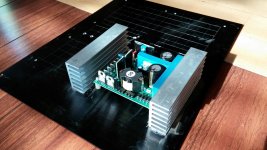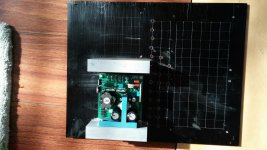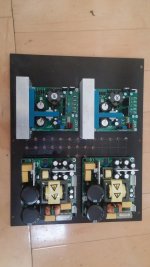Do you think that there would be a benefit to the dynamic level SMPS1200 power to use instead of SMPS600?
I've had the same question and decided to take SMPS1200. According to the spec. it provides more power and better corresponds to the nc400 power. But my decision is rather based on the issue with overheating capacitors in SMPS600: Dead Hypex SMPS600 V3 Power Supplies - notANON
Be aware that you need a special internal cabling. Here you can find a correct wiring for it: NC400 SMPS1200A400 wiring diagram
Regards Boris
I've had the same question and decided to take SMPS1200. According to the spec. it provides more power and better corresponds to the nc400 power. But my decision is rather based on the issue with overheating capacitors in SMPS600: Dead Hypex SMPS600 V3 Power Supplies - notANON
Be aware that you need a special internal cabling. Here you can find a correct wiring for it: NC400 SMPS1200A400 wiring diagram
Regards Boris
Thanks Boris for NC400 SMPS1200A400 wiring diagram,
very useful !
Dont want to start a war of words on the thread due to the very subjective nature of my questions. So my apologies to start with.
So as I had posted, I had finished my first NC400 amplifier.
Due to my heating concern, I did disassemble it to put several ventilation holes on the bottom plate. While doing this I also sanded off the anodization layer at points where the panels of the cabinet attached to each other using screws. Earlier just the rear panel was used for connecting the XLR shield, my hope was to allow the whole aluminum chassis to be a continuous conductive shield. This could have been totally misguided.
Anyway, once I put things back, I FELT the amp sounded different, different as in not as good as before my quick surgery. It could be a pure figment of my imagination
But do you see any likelihood of that happening due to the changes I mentioned?
Couple of other questions. I love the control and authority in bass generated by NC400, however I feel the treble range is rather subdued or underwhelmed by the bass.
Totally understand that this could just be my brain complaining about the difference with respect to the sound I am used to. NC400 could be doing what it was designed to do, amplify signals without adding any flavor of its own.
NC400 has a ruler flat freq response and vanishingly low THD. My question is, can just the DIY implementation of the chassis and rest of the assembly with the modules affect the sound in any noticeable way?
And what really is the noticeable effect? Any prominent noise can quickly be detected in the sound, but how does a slightly higher THD sound?
So as I had posted, I had finished my first NC400 amplifier.
Due to my heating concern, I did disassemble it to put several ventilation holes on the bottom plate. While doing this I also sanded off the anodization layer at points where the panels of the cabinet attached to each other using screws. Earlier just the rear panel was used for connecting the XLR shield, my hope was to allow the whole aluminum chassis to be a continuous conductive shield. This could have been totally misguided.
Anyway, once I put things back, I FELT the amp sounded different, different as in not as good as before my quick surgery. It could be a pure figment of my imagination
But do you see any likelihood of that happening due to the changes I mentioned?
Couple of other questions. I love the control and authority in bass generated by NC400, however I feel the treble range is rather subdued or underwhelmed by the bass.
Totally understand that this could just be my brain complaining about the difference with respect to the sound I am used to. NC400 could be doing what it was designed to do, amplify signals without adding any flavor of its own.
NC400 has a ruler flat freq response and vanishingly low THD. My question is, can just the DIY implementation of the chassis and rest of the assembly with the modules affect the sound in any noticeable way?
And what really is the noticeable effect? Any prominent noise can quickly be detected in the sound, but how does a slightly higher THD sound?
also are these excellent modules and power supply really that sensitive to the least complex part of the build - putting in a chassis and hooking up the cables.
Anyway, once I put things back, I FELT the amp sounded different, different as in not as good as before my quick surgery. It could be a pure figment of my imagination
Indeed. That is the problem with sighted listening.
Quite simply - no. The only things that your changes could cause are noise pickup / hum - that you would hear as noise, not subtle degrading of sound, or some strange loop-induced oscillation - not likely. Do you have access to an oscilloscope?But do you see any likelihood of that happening due to the changes I mentioned?
Lack of distortion can often be perceived as a "subdued" sound compared to systems that emphasize certain areas with distortion or uneven frequency response.Couple of other questions. I love the control and authority in bass generated by NC400, however I feel the treble range is rather subdued or underwhelmed by the bass.
Totally understand that this could just be my brain complaining about the difference with respect to the sound I am used to. NC400 could be doing what it was designed to do, amplify signals without adding any flavor of its own.
See above - all your changes could do is cause noise, but they would not cause increased THD - and anyway, a slight increase in THD would not be audible.NC400 has a ruler flat freq response and vanishingly low THD. My question is, can just the DIY implementation of the chassis and rest of the assembly with the modules affect the sound in any noticeable way?
And what really is the noticeable effect? Any prominent noise can quickly be detected in the sound, but how does a slightly higher THD sound?
Working on the first UcD400 amp tonight. Hope to post some pictures tomorrow.
Looking forward to the pics!
ran into some problem with the ucd400 assembly.
I just wasnt able to find a good way to fasten the ucd heatsink to small aluminium heatsink blocks which in turn are screwed on to the bottom plate of the chassis.
initially i was planning to screw the modules on to the heatsink blocks, however putting a hole thru the heatsink and getting the screw in through them and onto the module's blue heat sink was proving difficult.
Could use some heat sink adhesive pads to do the job, but may not be as good as a good mechanical coupling using screws.
The picture shows one module, the second one goes on the second aluminum heatsink. This is work in progress so pending cleanup.
I just wasnt able to find a good way to fasten the ucd heatsink to small aluminium heatsink blocks which in turn are screwed on to the bottom plate of the chassis.
initially i was planning to screw the modules on to the heatsink blocks, however putting a hole thru the heatsink and getting the screw in through them and onto the module's blue heat sink was proving difficult.
Could use some heat sink adhesive pads to do the job, but may not be as good as a good mechanical coupling using screws.
The picture shows one module, the second one goes on the second aluminum heatsink. This is work in progress so pending cleanup.
Attachments
One of my nCores has started 'wailing', it's the only way to describe it. And luckily two days before the warranty runs out, I have RMA'd it but what could cause such a thing?
Last edited by a moderator:
One of my nCores has started 'wailing', it's the only way to describe it. And luckily two days before the warranty runs out, I have RMA'd it but what could cause such a thing?
is it constant pitch, or does the pitch vary?
It's a pretty constant pitch , but quite a complex waveform so more painful to hear than a sine wave. It starts a few seconds after the amp comes online.
It's a pretty constant pitch , but quite a complex waveform so more painful to hear than a sine wave. It starts a few seconds after the amp comes online.
I assume you don't have access to an oscilloscope? It definitely sounds like either oscillation, or intermodulation product from switching frequency - in either case, it is a definite fault - failed component or connection, so let's see what Hypex says.
There's an old analog scope on my bench, but that is not going to give much insight into this problem.
So far the nCore failure rate in my house is 100%....
So far the nCore failure rate in my house is 100%....
There's an old analog scope on my bench, but that is not going to give much insight into this problem.
It wil tell the frequency and the wave shape of the noise.
So far the nCore failure rate in my house is 100%....
Wow! Is there anything special about your environment (temperature? mains spikes?)
Yeah but what I meant is that i can't freeze any data or zoom, take screen grabs etc to show you.
The first one failed after a few weeks. Immediate shutdown, Hypex replaced it for free. Now this one starts oscillating, and I noticed a few days previous that the SMPS was hotter than the other, and making a buzzing noise.
Nothing special about the environment, these amps are in my lounge and the mains is fine around here.
The first one failed after a few weeks. Immediate shutdown, Hypex replaced it for free. Now this one starts oscillating, and I noticed a few days previous that the SMPS was hotter than the other, and making a buzzing noise.
Nothing special about the environment, these amps are in my lounge and the mains is fine around here.
Last edited by a moderator:
Yeah but what I meant is that i can't freeze any data or zoom, take screen grabs etc to show you.
Fair enough.
I noticed a few days previous that the SMPS was hotter than the other, and making a buzzing noise.
Hmm - a failing SMPS could be the source of the wailing - but an oscillating amp could also put abnormal load on the SMPS.
I must admit that I have not tried the other amp with this SMPS yet. Maybe it is not the amp at all.
I must admit that I have not tried the other amp with this SMPS yet. Maybe it is not the amp at all.
Definitely worth trying.
Poti - balanced vs unbalanced
Gents, I'm finalising my design for 2xNC400 with 2xSMOS600 in dual mono setup, and would need your advice please:
- I need to connect an unbalanced source with no volume regulation built in (will use Hypex cable Interlink Stereo HG RCA-XLR M 0,75m to connect). Is it better to do the attenuation in the unbalanced domain with a regular stereo poti, or on the balanced side with a balanced poti? (e.g. from Audio Note Audio Note 100K Balance Potentiometer | Hifi Collective )
- Does it make a difference whether I put the poti close to the source or to the amps (thinking of length of balanced or unbalanced cable [albeit short at less than 1m], interference/intermodulation etc.)?
- Is a stereo poti like the above Audio Note ok, or are mono potis to be preferred here? (The inconvenience of having to regulate volume separately for either channel, versus sonic superiority...)
Gents, I'm finalising my design for 2xNC400 with 2xSMOS600 in dual mono setup, and would need your advice please:
- I need to connect an unbalanced source with no volume regulation built in (will use Hypex cable Interlink Stereo HG RCA-XLR M 0,75m to connect). Is it better to do the attenuation in the unbalanced domain with a regular stereo poti, or on the balanced side with a balanced poti? (e.g. from Audio Note Audio Note 100K Balance Potentiometer | Hifi Collective )
- Does it make a difference whether I put the poti close to the source or to the amps (thinking of length of balanced or unbalanced cable [albeit short at less than 1m], interference/intermodulation etc.)?
- Is a stereo poti like the above Audio Note ok, or are mono potis to be preferred here? (The inconvenience of having to regulate volume separately for either channel, versus sonic superiority...)
- Status
- Not open for further replies.
- Home
- Amplifiers
- Class D
- Hypex Ncore


